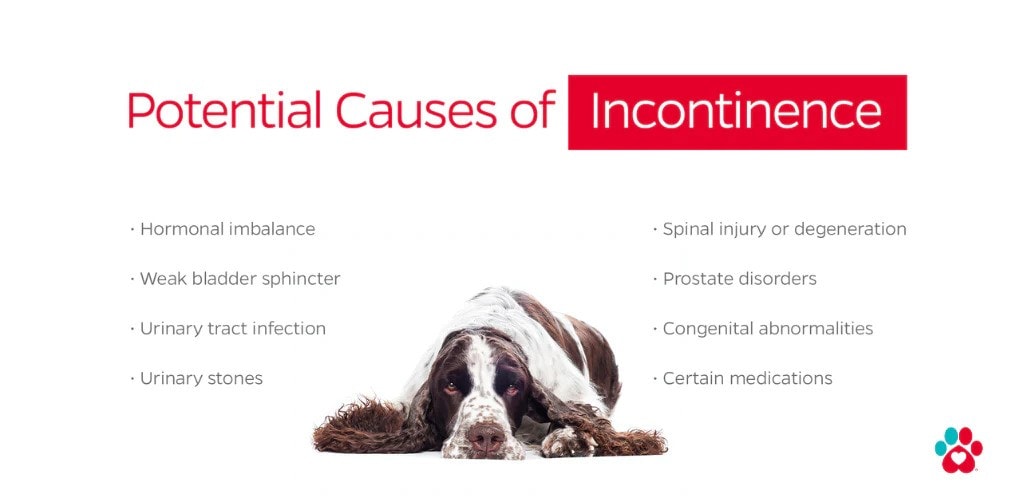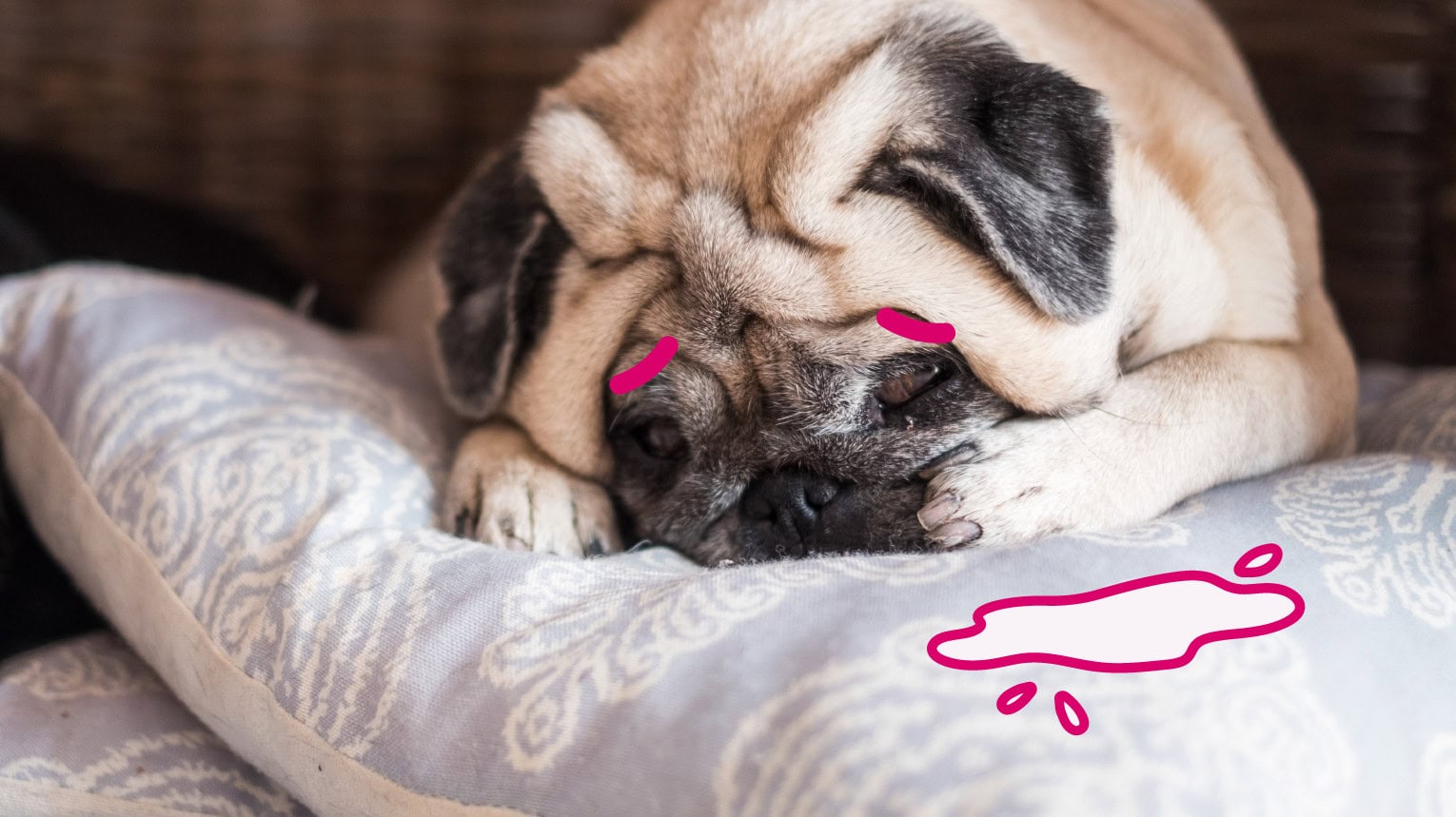As a veterinarian, I field a lot of questions about dog incontinence behaviors and accidents in the house. Many of the urinary accidents are due to incontinence, if your furry friend seems to be losing control of their bladder, it could be a sign of a medical condition.
What is Urinary Incontinence in Dogs?
Urinary incontinence in dogs is the involuntary leaking of urine, meaning your dog can’t fully control their bladder. This can range from small drops of urine to complete emptying when moving around or even while resting or sleeping.
Causes of Canine Incontinence

Age
Urinary incontinence is more common in older dogs. As dogs age, their muscles weaken, including the muscles of the bladder.
Urinary Tract Infections (UTIs)
UTIs in dogs cause inflammation and discomfort and can lead to frequent urination, leaking, and indoor accidents.
Neurological Issues
Certain neurological conditions that affect the spinal cord and surrounding nerves can cause dog incontinence.
Congenital Abnormalities
Some dogs are born with genetic conditions that cause leaking of urine. These include dogs with Ectopic Ureter or Spina Bifida.
Tumors
Urinary tract tumors, such as cancers affecting the kidneys, ureters, bladder, prostate gland (in males), and urethra could all cause frequent urination and incontinence in dogs.
Note: In some cases, veterinary surgery is necessary to remove cancerous tumors or repair structural issues and genetic defects.
Bladder Stones
Bladder stones are a painful condition in dogs that can cause difficulties urinating, urinating small amounts frequently and inappropriately.
Spay Incontinence
Following female dog spay surgery, the lower levels of estrogen sometimes can lead to relaxation of the muscles of the urethral sphincter when at rest, causing incontinence.
Urethral Sphincter Mechanism Incompetence (USMI)
USMI (Urethral Sphincter Mechanism Incompetence) is similar to spay incontinence, can affect both sexes but is more common in female dogs. It is when the muscles of the urethra become weak allowing the leaking or urine.
Medication Side Effects
Certain prescribed medications for dogs can make it harder for them to control their bladder muscles, leading to leaking and incontinence.
Symptoms of Urinary Incontinence
Some common symptoms of urinary incontinence in canines include:
- Urine spots on bedding, furniture, or floors
- Leaking small drops of urine while walking or standing
- Frequent urination, even in small amounts
- A strong urine odor
- Skin irritation around the genitals
Dogs With an Increased Risk
While any dog can experience incontinence, some characteristics can make them more at risk:
Older Dogs
As dogs age it is common for the muscles around the bladder to weaken. Mobility issues can also impact your canine companion’s ability to get outside in time.
Female Dogs
As I stated above, female spay surgery can disrupt hormone levels, leading to weakened urethral muscles in some females. USMI is also more common in female dogs.
Certain Breeds
Although the reasons are not clear, there are certain breeds which are more susceptible than others to having dog bladder control issues:
-
German Shepherds
-
Boxers
-
Dalmatians
-
Rottweilers
-
Weimaraners
-
Golden Retrievers
-
English Springer Spaniels
-
Doberman Pinschers
-
Old English Sheepdogs
-
Bearded Collies and Rough Collies
-
Irish Setters (male)
-
Bulldogs
Diagnosing Dog Incontinence
In my experience as a mobile veterinarian with BetterVet, I rely on a number of diagnostic tests to determine the underlying cause of urinary incontinence in dogs.
Tests that can identify incontinence may include:
-
Urinalysis
-
Ultrasound
-
Urine culture
-
Radiography (X-rays)
Treating Incontinence in Dogs
There are a number of options available to veterinarians to treat dog incontinence. These treatments fall into two categories: medications and home remedies for symptom management.
Medications
There are several medications that can effectively treat the symptoms of dog incontinence. Which medication is prescribed for your dog will depend on the diagnosed condition.
-
Phenylpropanolamine (PPA) – improves urethral sphincter tone
-
Hormone Replacements (for females) – estrogen strengthens muscles around urethra
-
Gonadotropin-Releasing Hormone (GnRH) – hormone therapy
Home Remedies
In addition to the medical options listed above, there are a few things you can try at home to manage the symptoms of dog incontinence.
- Use dog diapers – offers protection and peace of mind for dogs who leak urine
- Place pee pads inside – If your dog can’t wait to pee outside or urinates involuntarily, providing a designated pad can save your carpet and floors.
- Make frequent trips outside – Short trips outside where your dog can empty their bladder will help to minimize accidents, especially before bed time.
- Maintain proper hygiene – clean your dog’s genital area regularly to prevent skin irritation.
Conclusion
At BetterVet, we understand the challenges of caring for an incontinent dog. Our compassionate team is here to diagnose your dog in the comfort of home and develop a personalized treatment plan.
Book an in-home or virtual appointment for guidance about your pet’s urinary and overall health today.
Frequently Asked Questions
What can you do for a dog with incontinence?
As a veterinarian with BetterVet, I would start with a comprehensive in-home exam to diagnose the cause of the condition, and would then create a treatment plan that may include medication or surgical intervention.
Should I take my dog to the veterinarian for incontinence?
Yes, your dog should be seen by a veterinarian to explore the causes for urinary leaking and indoor accidents so they can be treated accordingly. In-home veterinary care is a great option for dogs who cannot hold their bladders to avoid accidents in the car, crate, or veterinary clinic.
At what age do dogs become incontinent?
Generally speaking, dogs are considered seniors when they reach age 7-9 years old, this is when age-related dog incontinence becomes more common. Hormonal causes of incontinence can develop as early as 2-4 years old.





